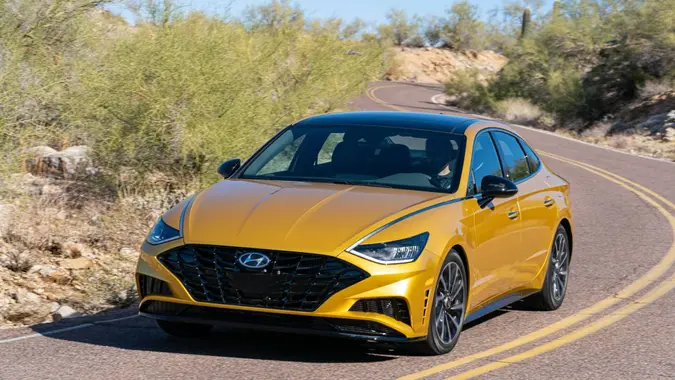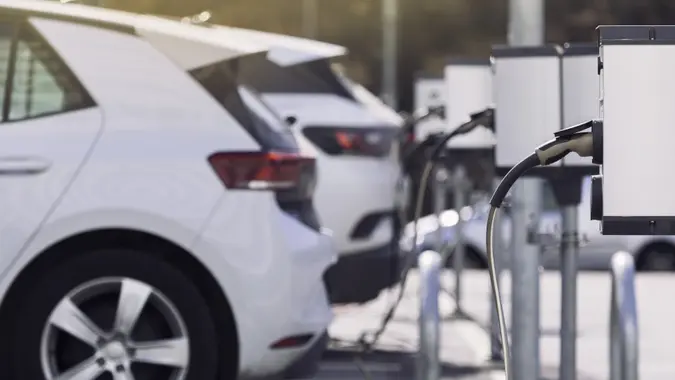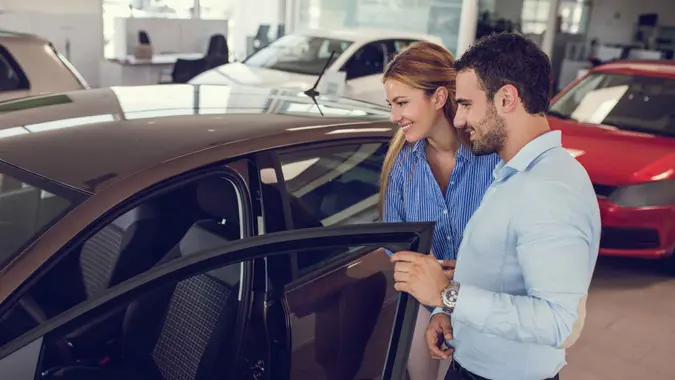7 Hatchbacks To Avoid Buying in 2025
Commitment to Our Readers
GOBankingRates' editorial team is committed to bringing you unbiased reviews and information. We use data-driven methodologies to evaluate financial products and services - our reviews and ratings are not influenced by advertisers. You can read more about our editorial guidelines and our products and services review methodology.

20 Years
Helping You Live Richer

Reviewed
by Experts

Trusted by
Millions of Readers
Popularity trends run through every industry, and the automobile racket is no different. Pickup trucks and SUVs are by far the best selling vehicle types in the U.S., but electric vehicles (EVs) are gaining ground every year.
Though considered a bit niche, hatchbacks are still sought after by those who want the versatility of an SUV without the price tag. Warm hatchbacks, which fall between standard hatchbacks and “hot hatches” — high-performance variants — have become surprisingly popular, according to GoodCarBadCar. Many are looking for “fuel-efficient and fun-to-drive” cars among American consumers.
GOBankingRates asked auto expert Chris Pyle, who operates as a full-time virtual mechanic at expert on-demand platform JustAnswer, and Deege Carse, Director at Trackershop, UK supplier of GPS trackers and vehicle security solutions, about buying a hatchback in 2025. Here are seven they, and consensus reviews, suggest you avoid.
1. Chevrolet Bolt
After first announcing the Chevy Bolt and Bolt EUV would be phased out by the end of 2023, GM later confirmed the mark would make a comeback in 2025, as a model year 2026 all-electric vehicle line only. Chevrolet’s first mass-market electric vehicle was popular due to its affordability. However, the car suffered from significant recalls related to defective battery fires, per TopSpeed.
Electric Bolts from 2023 are still widely available, but might not be the best choice for consumers due to their “poor battery range” and interior space. “They’re not comfortable for larger people,” said Pyle.
2. Mitsubishi Mirage
The Mitsubishi Mirage is super cheap, but not as cheap or good as the Nissan Versa or Chevy Spark, according to Car and Driver. Mitsubishi is discontinuing the Mirage after the 2024 year, and for the car culture print and digital magazine, it can’t come soon enough.
The Mirage’s performance is anemic at best, and the subcompact “somehow feels even cheaper than its low price suggests,” Car and Driver said.
3. Nissan Leaf
The Leaf is still a good and affordable starting point into the world of EVs, but it has a lot of competition with better charging and range capabilities. Pyle agreed, faulting the Leaf for its “premature battery failure, low battery range and long charging wait times.”
Meanwhile, Carse has problems with the Leaf’s drive: “Ride comfort in this hatchback is less than ideal. Suspension feels loose, with sudden impacts like speed bumps and potholes causing small amounts of jolt that would otherwise have been absorbed by better models. If you ride along undulating and bumpy roads, expect less than stellar ride comfort, as you’d get a ton of movement and head bobbing.”
Carse didn’t stop there.
“Visibility could be better,” he added. “Windscreen pillar are a tad too thick, which can block diagonal view at roundabouts. Infotainment system is serviceable overall, but the resolution of the car’s touchscreen is dissatisfying and can be hard to see in daylight or bright conditions. Overall, tech feels dated despite updates done over the years. Interior as a whole is not great if you’re using standards set by other electric cars currently on the market.”
4. Ford Escape
Upon review, Car and Driver and Edmunds both gave the 2025 Ford Escape 3.8 and 3.9 out of 5.0, respectively. Those aren’t bad ratings, but fall short of its rivals, like the similarly-priced Honda CR-V and Mazda CX-5. Lifeless handling and a jerky transmission are the Escape’s key problems, per Edmunds, while Car and Driver claimed the refreshed model suffers from a stiff ride and an underwhelming driving experience.
5. Hyundai Veloster
When it published its model guide for 2023, Hyundai noted the termination of the IONIQ HEV and PHEV, and the Veloster N, making room for the brand to expand its N series with the Kona and Elantra, noted PBS’s MotorWeek. Popularity on the used market is a cause for concern for Pyle, which is actually good news for cult car enthusiasts. “The resale value takes a large plunge, making it basically worthless to trade it in,” he said. “It feels like you are giving a perfectly running car away for nothing in return.”
6. Nissan Versa
The Nissan Versa subcompact sedan is the cheapest car in the U.S., and will be the only new car that you can buy for under $20,000 in 2025. But that won’t stop the company from raising prices in 2025, attributing the $500-$640 trim increases to the addition of standard LED headlights, according to MotorTrend. Older hatches and Versa Notes (2013-2019) are sought after by consumers for the same reasons new Versas are: the low price point.
7. Mini and Fiat Hatchbacks
Like Toyota’s discontinued Scion subsidiary, hatchbacks produced by Stellantis and BMW under the Fiat and Mini brands get a thumbs down from Pyle. “They’re great cars until they fail, and although the crash ratings are good, repair costs are very expensive,” he said. When these powerless tykes go up against what’s currently dominating the highways, things “do not end well,” remarked Pyle.
More From GOBankingRates
 Written by
Written by  Edited by
Edited by 


























